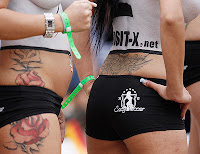
The Art of Body Painting and Tattoos Soccer 2012
By: AlexxpuNkreaNk GrEzIkaYa. at 05:40 - 23/06/2012
Henna tattoos or paintings can be a lot of fun. Whether you're painting yourself or some else, you will get a lot of satisfaction from actually being involved in the process itself, and in watching your design as it evolves and alters in the weeks to come.
 Henna is a completely natural product that has been used for thousands of years. However, if you have particular sensitive skin and are concerned about an allergic reaction, do a skin test before you start. To do this, apply a small amount of paste to a part of the body, scrape it off and wait for 24 hours. If there is no allergic reaction you should be safe to carry on.
Henna is a completely natural product that has been used for thousands of years. However, if you have particular sensitive skin and are concerned about an allergic reaction, do a skin test before you start. To do this, apply a small amount of paste to a part of the body, scrape it off and wait for 24 hours. If there is no allergic reaction you should be safe to carry on. Caution should also be taken when using essential oils. Always remember to use them to their correct dilution. If unsure, find out what you need to know before proceeding - never take a chance.
Caution should also be taken when using essential oils. Always remember to use them to their correct dilution. If unsure, find out what you need to know before proceeding - never take a chance.
Finally, make sure you know what you are doing before you begin - remember, henna stains as soon as it is applied! Getting ready to start is as important as the painting itself.
1 Make sure your work surfaces are clean and if necessary protected - remember henna stains just about anything.
2 Protect your own clothing and if necessary tie your hair back
3 Get all your materials ready. Get some water ready. Get your design ready.

Henna Paste
Pre-mixed paste is probably the easiest sort to use. It comes readymade, in a tube with a nozzle. All you have to do is use it. Paste form can be bought from ethnic shops and in some Indian supermarkets. You can also order it direct from retailers worldwide via the internet. Colors include natural, black, blue, green, orange, red and purple, turquoise and brown. It is important to follow the instructions which come with the premixed pastes as some do not require the use of Mehndi oil when applying your designs usually these are the colored pastes.
 Henna powder is what the professionals use. Its best bought from a recognized supplier rather than at your local store, as it is important that it is fresh. There are many different recipes for making henna paste. Remember, once mixed the paste only lasts for three days, so don't make up too much. If you have some left over, you can refrigerate it for a couple of days. The recipe below is one that is commonly used. It will make enough paste for 8 to 10 simple designs.
Henna powder is what the professionals use. Its best bought from a recognized supplier rather than at your local store, as it is important that it is fresh. There are many different recipes for making henna paste. Remember, once mixed the paste only lasts for three days, so don't make up too much. If you have some left over, you can refrigerate it for a couple of days. The recipe below is one that is commonly used. It will make enough paste for 8 to 10 simple designs. This is what you do:
This is what you do:1 Boil the water
2 Add the tea bag. For the blackest pigment, leave a tea bag standing in it overnight.
3 Put the sifted henna into a bowl. Add the oil, but do not mix.
4 Using a metal spoon add two tablespoons of the tea to the powder, stirring as you go.
5 If the mixture is stiff, add slightly more liquid. Mix well, pressing out any lumps with the back of the spoon.
6 Seal the container with cling-film and cover. Then leave the paste to stand for at least four hours, away from direct sunlight. What you have in the end is a smooth, set paste.
Applicators
Most professionals use a plastic cone to apply henna to the skin. This looks a lot like an icing bag. If you buy a paste kit, then you get one free. You can improvise, of course. Good alternatives are a child's medicine syringe: ask your local chemist for this or an icing bag with a fine nozzle.
There are other applicators.
Professionals use fine wooden sticks for detail work. Here again, you can improvise. Toothpicks are good, also nail-care sticks. You can also buy applicator bottles which are sold with a variety of nozzle sizes. These are very easy to use and less messy than the bags, good for beginners.
Sundries
To prepare the skin, clean it and set your design afterwards you will need:
Cleaners - soap and water or rosewater
Oils - eucalyptus oil, baby oil, olive oil
Lemon and sugar
While working on your design, make sure you have the following close to hand:
Cotton wool balls and swabs
Flat toothpick or rounded flat knife
Paper towels
Toilet paper and Scotch tape
Application
When applying any henna design if you follow the steps below you won't go far wrong. Obviously you need to change your methods depending on what kind of template and design you are working to, for instance if using a stencil as opposed to freehand design the application is less precise.
1 First cleanse the area of the skin you are going to work on with soap and water and a cotton wool swab. You may like to use rose water instead.
2 Once dry, if you are using an adhesive stencil carefully place it in the correct position and make sure it sticks well to your skin without lifting at the edges. Do this before applying any oil to your skin or the stencil will not stick successfully.
3 If you are going to use natural henna for your tattoo design, you need to gently swab the area with diluted eucalyptus oil or clove oil (also called Mehndi oil) to help prepare the skin for the dye. (Note: any essential oil needs to be diluted before use - follow instructions for correct dilution ration.) If you are using colored henna, in the main, oil is not required.
4 You are now ready to draw your motif. Slowly flow the henna on to the skin, as if you were icing a cake. Don't apply too much at once. If you are using stencil, cover the area with an even layer of henna, making sure that the clear areas of the stencil are all covered.
Use cotton wool swabs and toothpicks to adjust lines or remove any mistakes.
Clean your applicators frequently, using paper towels. Use a needle or pin to clean the applicator nozzle if it gets blocked.
5 When you have finished applying wait for the design to dry. This takes around 10 to 15 minutes. The henna paint is dry when it looks flat rather than shiny and wet. Do not wait for it to start cracking, however.
6 You now need to moisturize the paint, to encourage it to seep into the skin. Do this by either applying a solution of sugar and lemon - half a lemon to one teaspoon of sugar is enough to fix one average-sized motif - or pre-mixed Mehndi oil. Gently dab the moisturizing solution onto the henna paint using cotton wool swabs. Don't use too much solution - you don't want to wash off the paint.
Keep moisturizing whenever you notice the paint beginning to dry out. After a while the paint will retain the solution, and will stay moist.
7 For the stain to really take effect, the paint needs to stay on the skin for a minimum of five hours. Ideally it should stay there for eight hours, and overnight, if possible. Basically, the longer you leave the paint on the skin, the darker the design will be.
If you can bear to leave the henna paint overnight, the best way of keeping it on is to cover the whole area in paper tape to protect it - you may also use a sealing product such as New-Skin, a spray-on fixative that seals the henna tattoo design while the stain develops.
8 When the motif has fully developed, take a clean cotton wool swab and rub the design to remove the paste. Any stubborn paint can be removed using a blunt knife blade. If you have used a stencil peel it off very carefully and clean off any adhesive that has been left by the stencil using a little diluted Mehndi oil.
Aftercare
The color you see when you first remove the paste is not the full color, this appears around 24 hours later and will be much stronger.
Try not to wash new henna motifs, at least for a day or so. This will improve their life - span.
Using a moisturizer on the motif will help extend its life. Do not apply more than twice a day, however.
What, when, why? Some questions and answers.
How long does your henna tattoo last?
The stain can last up to a month, although most products tell you they last up to three weeks. In fact, it all depends on what part of the body you are applying it to, what type of skin you have, and how much that area gets washed and scrubbed. It also depends on how long you leave the past on before scraping it off.
What parts of the body are good to paint?
Palms and soles of the feet are the warmest parts of the body and have the thickest skin. This means that the henna will penetrate further, and so the painting lasts longer. Other areas that are good for tattoos are wrists, finger tips, forearms and the waist. Face and chest areas do not work very well, as the skin here is quite thin and exfoliates quickly.
Does henna only come in one color?
It can vary in color from light orange to reddish brown, depending on the type used. You may have heard of 'black henna', which is also used. This is not recommended as it can be dangerous to the skin. Other colors, likewise, are not true henna and are therefore best avoided.
How long does it take?
How long a painting takes depends on how complicated it is. It might take 15 minutes to draw a simple motif, several hours to complete a wrist bracelet.
Dows it hurt?
Absolutely not! In fact, it is quite soothing.
For a wider and more general choice of tattoo and henna images please browse many here at miscellaneous tattoos